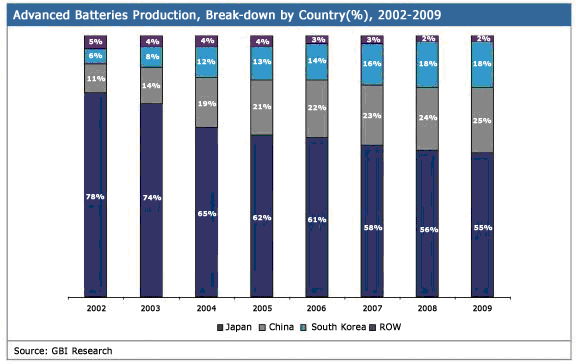
As the automotive industry transitions to electric vehicles, companies developing lithium-ion battery technology will make strides. Li-ion technology is quickly replacing nickel-metal hydride batteries in hybrid electric vehicles, and the advanced battery market for emerging plug-in hybrid vehicles will be worth billions of dollars within a decade, according to a report by market research firm GBI Research. But while Japanese manufacturers currently control a majority of the global advanced battery market, South Korean and especially Chinese firms are drawing closer.
Nickel-metal hydride batteries account for 97% of the hybrid electric vehicle market by revenue. But the nickel-metal hydride technology has reached its maturity, Li-ion technology is advancing more quickly and offers better overall performance characteristics, such as longer life, high energy density, and is more light weight. The report estimates that hybrid electric vehicles will make up 10% of new sales by 2020 and that Li-ion batteries will be in more than 60% of those cars and trucks. But plug-in hybrid electric vehicles could be an even bigger opportunity for advanced battery makers. The authors believe the automotive industry will evolve from hybrid electric to plug-in hybrid electric vehicles �in the near future� and that the pace of the transition will be much faster than expected. This shift will provide a �huge sales growth� opportunity for advanced batteries, Li-ion batteries in particular. The report estimates that global plug-in vehicles sales will reach 1% of the light-duty vehicle market by 2015 and 5.3% by 2020. That could translate into a global plug-in vehicle battery market of US$17.3 bln by 2020. Advanced battery manufacturing currently is dominated by China, Japan and South Korea, together accounting for 98% of the market in 2009. While Japan�s share of the market will remain significant in the near term, GBI researchers say that the country�s dominance is �fading away.� Japanese manufactures controlled 55% of global advanced battery production in 2009, down from 78% in 2002. Meanwhile, China�s share rose to 25% in 2009 from 11% in 2002, and South Korea�s reached 18% in 2009 from just 6% in 2002 (See chart below). China offers advantages of attractive government incentives and cheap labor, which has allowed manufacturers there to replace a conventionally capital-intensive business using automated production lines with a labor-intensive one that relies on people-power in its production lines. Aware of these advantages, Japanese and Western companies are fast entering into partnerships with Chinese battery manufactures. Warren Buffet has invested US$230 mln into BYD Company, a Shenzhen-based battery and electric car maker gearing up to sell electric cars in the US starting in 2011. According to previous reports, hybrid cars will be truly mass-market in China by 2011 or 2012, and the country�s fleet will begin a minimum 10-year transition to plug-in hybrids and battery-electric vehicles as early as this year. As per Wikipedia, the Toyota hybrids combined with Lexus reached 1 million hybrids sold in the US by February 2009, and worldwide sales of hybrids by both brands totaled over 2 million vehicles by August 2009. As the top selling hybrid in both US and Japan, the Toyota Prius reached cumulative sales of 1.8 mln worldwide as of July 2010. Worldwide, Toyota Motor Company is the leader with more than 2.68 mln hybrids sold by July 2010, followed by Honda Motor Co., Ltd. with more than 300,000 hybrids sold by January 2009 and Ford Motor Corporation with more than 100,000 hybrids sold by December 2009. Over 3 million hybrid electric vehicles have been sold globally by July 2010, led by the United States with almost 1.8 million units, followed by Japan with more than 1 million units and Europe with more than 200,000. In the US, California has been the state leading hybrid sales in USA, followed by New York and Florida. Hybrid sales in Japan almost triple in 2009 from 2008 as a result of government incentives that included a scrappage program, tax breaks on hybrid vehicles and other low emission cars and trucks, and a higher levy on gasoline that pushed up prices. |
Previous Article
Next Article
{{comment.DateTimeStampDisplay}}
{{comment.Comments}}